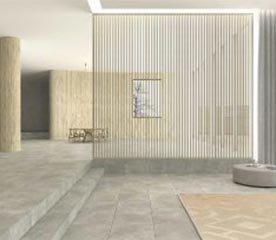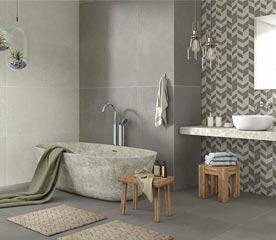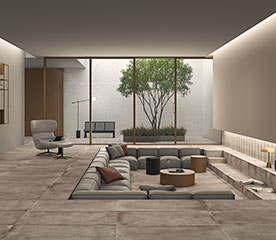TILE INSTALLATION
PORCELAIN TILES (Bla GL)
Porcelain tiles are manufactured using pure, selectively imported raw materials mixed using the most advanced extraction and sorting techniques; they are obtained with a production process similar to that of single-fired tiles. The resulting product is top-quality porcelain tile, obtained by raw materials wet grinding, followed by partial drying by spraying, silo storage to allow homogenization of properties, and pressing with highly efficient hydraulic presses up to specific pressures more than 500 kg/cm2. The high pressure combined with high firing temperature exceeding 1200 °C results in highly compact & strong ceramic surface with very low water absorption (lower than 0.1% according to UNI EN ISO 10545-3) and extremely high mechanical resistance (average value exceeding 50 N/mm2 according to UNI EN ISO 10545-4).
Thanks to their low porosity, these porcelain tiles are frost-proof and rated as belonging to the BIa GL class according to the European Standard UNI EN 14411 which requires water absorption ≤ 0.5%.
The MoR (modulus of rupture) in accordance with UNI EN ISO 10545-4 results to 50 N/mm2 while the required value is 35 N/mm2. RAK Ceramics porcelain tiles are available in a wide range of designs, sizes and finishes.
ADVICE ON LAYING
Although our porcelain tiles can be installed using traditional cement mortars, we advise using modern adhesives. While installing on wall, the two-layer spreading system is recommended to perfectly wet the back of the tile. Quickly dipping each tile in water before installation will remove any dust on the back of the tile for perfect adhesion.
Do not wet the tiles if you are using vinyl, acrylic resin adhesives or two- component organic-solvent based adhesive. It is advisable to incorporate suitable shrinkage - flexion joints (movement/ expansion joints) when installing on large floors: the joints should never be spaced more than 4 - 5 linear meters apart indoors and 3 linear meters apart outdoors. Be careful while using strong coloured grouts as they might leave stains on the surface of the tiles that may be difficult to remove later.
FULL BODY PORCELAIN (Bla UGL)
Full body porcelain tiles are manufactured using pure, selectively imported raw materials mixed using the most advanced extraction and sorting techniques; they are obtained with a production process similar to that of single-fired tiles. The resulting product is top-quality porcelain tile, obtained by raw materials wet grinding, followed by partial drying by spraying, silo storage to allow homogenization of properties, and pressing with highly efficient hydraulic presses up to specific pressures more than 500 kg/cm2. The high pressure combined with high firing temperature exceeding 1200 °C results in highly compact & strong ceramic surface with very low water absorption (lower than 0.1% according to UNI EN ISO 10545-3) and extremely high mechanical resistance (average value exceeding 50 N/mm2 according to UNI EN ISO 10545-4).
Full body porcelain tiles are suitable for heavy traffic areas as they are characterized by a deep abrasion resistance (equal to 140 mm3 of removed material, as opposed to the 175 mm3 provided for by the UNI EN ISO 10545-6 standard).
Thanks to their low porosity, these tiles are frost-proof and rated as belonging to the BIa UGL class according to the European Standard UNI EN 14411 which requires water absorption ≤ 0.5%.
Chemical acid and base resistance (UNI EN ISO 10545-13) makes full body porcelain tiles suitable for environments where aggressive chemicals are used, e.g. food processing factories, hospitals, chemical or pharmaceutical plants. The full body porcelain tiles are available in a wide range of sizes and surfaces (slip-resistant finish also available).
ADVICE ON LAYING
Although our porcelain tiles can be installed using traditional cement mortars, we advise using modern adhesives. While installing on wall, the two-layer spreading system is recommended to perfectly wet the back of the tile. Quickly dipping each tile in water before installation will remove any dust on the back of the tile for perfect adhesion.
Do not wet the tiles if you are using vinyl, acrylic resin adhesives or two- component organic-solvent based adhesive. It is advisable to incorporate suitable shrinkage - flexion joints (movement/ expansion joints) when installing on large floors: the joints should never be spaced more than 4 - 5 linear meters apart indoors and 3 linear meters apart outdoors. Be careful while using strong coloured grouts as they might leave stains on the surface of the tiles that may be difficult to remove later.






